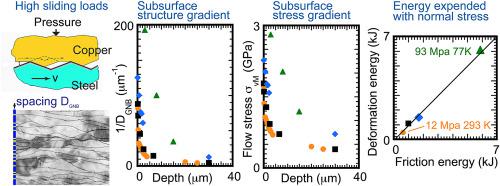International Journal of Machine Tools and Manufacture ( IF 14.0 ) Pub Date : 2021-06-22 , DOI: 10.1016/j.ijmachtools.2021.103766 Darcy A. Hughes , John S. Korellis

|
The plowing action of ridge and wedge shaped micro asperities under large sliding loads is utilized to induce extremely high hardness and strain levels in the subsurface regions of Cu. A unique apparatus was designed and employed to apply high normal stresses (loads) that ranged herein from 0.4 to 3.7 times the yield stress, at either ambient (293 K) or cryogenic (77 K) temperatures. A steep gradient in the size scale of the induced deformation microstructures is coupled to an unprecedented average size (crystallite) scale of 5 nm that includes a high dislocation density near the surface. This structural size is graded in size from very fine at the surface to large with increasing depth and decreasing strain. Due to these size scales, quantitative and statistical measurements of the subsurface deformation microstructures, as a function of depth, load, and temperature were performed with high resolution transmission, scanning electron, and microprobe microscopy. The observed deformation microstructures follow the principal of grain subdivision creating a hierarchical structure, but with a finer size scale, that is similar to deformation structures developing under different deformation modes. The measured structure parameters include the inverse spacing, , of deformation induced boundaries (geometrically necessary boundaries GNBs), that have evolved with increasing strain to have medium to high misorientation angles like grain boundaries, and the dislocation density, , in between the GNBs. Dislocation mechanisms were demonstrated to dominate the subsurface deformation at all size scales based on the high density of dislocations, the average refinement that extends to 5 nm, and universal scaling. Subsurface stress estimates use the measured parameters in a linear addition of the classic Hall-Petch formulation for the barrier strength contribution of , plus Taylor forest dislocation hardening for the contribution of . A further unification of these parameters is made since is directly proportional to . Flow stress estimates indicate that the nearest subsurface layers are extremely hard, 1.7–2.8 GPa with hardness and subsurface refinement increasing with increasing normal load and decreasing temperature. At the highest load and 77 K, the depth at which large shear strains are observed is increased by a factor of about six, i.e. eighty times the average platen asperity height. A quantitative comparison of friction and deformation energies is made together with the stress and strain estimates. Friction and deformation energies increase with increasing the normal loads. At the same time, coefficients of friction decrease due to the creation of a harder surface at higher loads. Large sliding or rubbing loads are present during cutting and metal forming creating subsurface deformation. These loads largely contribute to high friction forces, and strongly influence surface finishes and subsurface hardness.
中文翻译:

用于切削和金属成形的高负荷滑动、变形微观结构、强度和硬化
在大滑动载荷下脊状和楔形微凹凸的犁形作用被用来在 Cu 的亚表面区域产生极高的硬度和应变水平。设计并采用了一种独特的装置,以在环境温度 (293 K) 或低温 (77 K) 温度下施加高正应力(载荷),这里的应力范围为屈服应力的 0.4 到 3.7 倍。诱导变形微结构尺寸尺度的陡峭梯度与前所未有的 5 nm 平均尺寸(微晶)尺度相结合,其中包括表面附近的高位错密度。随着深度的增加和应变的减少,这种结构尺寸的尺寸从表面非常细到大。由于这些尺寸尺度,地下变形微观结构的定量和统计测量,作为深度的函数,负载和温度通过高分辨率透射、扫描电子和微探针显微镜进行。观察到的变形显微组织遵循晶粒细分的原理,形成层次结构,但具有更精细的尺寸尺度,类似于在不同变形模式下形成的变形结构。测得的结构参数包括反间距、, 变形诱导边界(几何必要边界 GNB),随着应变的增加,具有中到高的取向差角(如晶界)和位错密度, ,在 GNB 之间。基于位错的高密度、延伸至 5 nm 的平均细化和普遍缩放,位错机制被证明在所有尺寸尺度下主导地下变形。次表面应力估计使用测量参数线性添加经典的 Hall-Petch 公式,用于势垒强度贡献,加上泰勒森林位错硬化的贡献 . 这些参数的进一步统一是因为 正比于 . 流动应力估计表明,最近的地下层非常坚硬,为 1.7-2.8 GPa,硬度和地下细化随着法向载荷的增加和温度的降低而增加。在最高负载和 77 K 时,观察到大剪切应变的深度增加了大约 6 倍,即平均压板粗糙高度的 80 倍。摩擦和变形能的定量比较与应力和应变估计一起进行。摩擦和变形能随着法向载荷的增加而增加。同时,由于在较高负载下会产生更硬的表面,摩擦系数会降低。在切割和金属成型过程中会出现大的滑动或摩擦载荷,从而产生次表面变形。这些载荷在很大程度上导致高摩擦力,



























 京公网安备 11010802027423号
京公网安备 11010802027423号